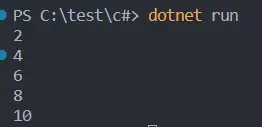Create Map and Reduce Functions in C#
-
Use LINQ to Create
MapandReduceFunctions in C# -
Create
MapandReduceFunctions From Scratch in C# - Conclusion

The Map and Reduce functions in C# are developed for writing algorithms for processing a large amount of raw data. Parallel computing allows developers to process such massive scales of distributed data to run the required computation close to where the data is located.
In this tutorial, you will learn two different methods to use and create the Map and Reduce functions and their implementation in C#. You can either write these functions from scratch or with the help of LINQ while hiding the complexities of parallelization, data distribution, fault tolerance, etc.
Both Map and Reduce functions run on an independent set of input data, and each function processes its data source.
The Map and Reduce cluster involves multiple computers that introduce additional complexity into the process. C# developers must be familiar with multi-threaded programming and locking when writing algorithms of Map and Reduce programs executed in parallel.
Use LINQ to Create Map and Reduce Functions in C#
The Map and Reduce functions implement various mathematical algorithms to divide tasks into small parts and assign them to multiple systems. In technical terms, the Map and Reduce algorithms help send the sorting, searching, indexing, and other Map and Reduce tasks to appropriate servers in a cluster.
While Map and Reduce functions using LINQ are agile and resilient approaches to solving big data problems, their inherent complexity means it takes time for C# developers to gain expertise. The logical execution of a simple Map and Reduce program looks like this:
// Logical execution
map(String key, String value):
// key: it holds the name of a document
// value: it holds the content of a document
for each word i in value:
EmitIntermediate(i, "1");
reduce(String key, Iterator values):
// key: it represents a word
// values: it holds the values of a work
int result = 0;
for each x in values:
resultReduce += ParseInt(x);
Emit(AsString(resultReduce));
Functional C# programming with LINQ is a popular approach to writing algorithms. LINQ and C# 3.5 and above have similar functions under different names.
Syntax:
Map Function:
var mappedCollection = collection.Select(element => transformationLogic);
collection: The input collection on which the map operation is performed.element: The individual element of the collection.transformationLogic: The logic to transform each element.
Reduce Function:
var reducedValue = collection.Aggregate(initialValue, (accumulator, element) => aggregationLogic);
collection: The input collection on which the reduce operation is performed.initialValue: The initial value of the accumulator.accumulator: The accumulated result.element: The individual element of the collection.aggregationLogic: The logic to aggregate the elements.
Using LINQ, you can implement the Map and Reduce programs described above:
Map function in C# using LINQ:
using System;
using System.Collections.Generic;
using System.Linq;
class Program {
static void Main() {
// Map Function: Doubling each number
List<int> numbers = new List<int> { 1, 2, 3, 4, 5 };
var doubledNumbers = numbers.Select(x => x * 2);
// Output
foreach (var num in doubledNumbers) {
Console.WriteLine(num);
}
}
}
In the map function example, we leverage LINQ’s Select method to efficiently iterate over the numbers list and apply the transformation logic to each element. By using a lambda expression (x => x * 2), we define the transformation directly within the method call, doubling each number in the list.
This functional approach abstracts away the iteration details, allowing us to focus on the transformation logic itself. With the resulting doubledNumbers collection, we iterate over it using a foreach loop and print each doubled number to the console.
Output:

Reduce function in C# using LINQ:
using System;
using System.Collections.Generic;
using System.Linq;
class Program {
static void Main() {
// Reduce Function: Summing all numbers
List<int> numbers = new List<int> { 1, 2, 3, 4, 5 };
int sum = numbers.Aggregate(0, (total, num) => total + num);
// Output
Console.WriteLine(sum);
}
}
In the reduce function example, we utilize LINQ’s Aggregate method to efficiently compute the sum of all numbers in the numbers list. By providing an initial value of 0 for the accumulator and specifying the aggregation logic using a lambda expression (total, num) => total + num), we effectively iterate over the collection and accumulate the sum.
This functional approach abstracts away the iteration details, allowing us to focus solely on the aggregation logic. With the resulting sum variable, we simply print it to the console, showcasing the simplicity and power of functional programming techniques in data aggregation tasks.
This concise and expressive code enhances readability and maintainability, demonstrating the benefits of using LINQ in C# for such operations.
Output:

Create Map and Reduce Functions From Scratch in C#
In C#, map and reduce functions can also be implemented from scratch without relying on built-in methods or libraries. This approach involves writing custom logic to iterate over the collection and perform the desired transformations or aggregations.
While more labor-intensive, creating maps and reducing functions from scratch provides a deeper understanding of their underlying principles and enhances programming skills.
Syntax:
Map Function:
List<TResult> Map<T, TResult>(List<T> collection, Func<T, TResult> transformationLogic) {
List<TResult> mappedCollection = new List<TResult>();
foreach (var item in collection) {
mappedCollection.Add(transformationLogic(item));
}
return mappedCollection;
}
List<TResult>: Indicates the return type of the function, which is a list of typeTResult, representing the transformed elements.<T, TResult>: These are generic type parameters used to make the function flexible enough to handle different types of input collections and transformations.Trepresents the type of elements in the input collection, andTResultrepresents the type of elements in the resulting mapped collection.(List<T> collection, Func<T, TResult> transformationLogic): These are the function parameters.collectionis a list of typeT, representing the input collection, andtransformationLogicis a delegate that represents the transformation logic to be applied to each element.
Reduce Function:
T Reduce<T>(List<T> collection, Func<T, T, T> aggregationLogic, T initialValue) {
T accumulator = initialValue;
foreach (var item in collection) {
accumulator = aggregationLogic(accumulator, item);
}
return accumulator;
}
T: Indicates the return type of the function, which is the final aggregated value.<T>: This is a generic type parameter used to make the function flexible enough to handle different types of input collections and aggregation operations.(List<T> collection, Func<T, T, T> aggregationLogic, T initialValue): These are the function parameters.collectionis a list of typeT, representing the input collection,aggregationLogicis a delegate that represents the aggregation logic to be applied to each element, andinitialValueis the initial value of the accumulator.
Example:
Map function in C# from scratch:
using System;
using System.Collections.Generic;
class Program {
static void Main() {
// Map Function: Doubling each number
List<int> numbers = new List<int> { 1, 2, 3, 4, 5 };
List<int> doubledNumbers = Map(numbers, x => x * 2);
// Output
foreach (var num in doubledNumbers) {
Console.WriteLine(num);
}
}
static List<TResult> Map<T, TResult>(List<T> collection, Func<T, TResult> transformationLogic) {
List<TResult> mappedCollection = new List<TResult>();
foreach (var item in collection) {
mappedCollection.Add(transformationLogic(item));
}
return mappedCollection;
}
}
In the map function example, we define a custom Map function that iterates over the numbers list and applies the specified transformation logic to each element. By using a generic type for both input and output, we ensure flexibility in handling different types of collections and transformations.
Inside the Map function, we initialize an empty list mappedCollection to store the transformed elements. We then iterate over each item in the input collection, applying the transformation logic using a lambda expression (x => x * 2) in this case and adding the result to the mappedCollection.
Finally, we return the resulting mapped collection. By implementing the map function from scratch, we gain a deeper understanding of its underlying mechanics and enhance our programming skills in C#.
Output:

Reduce function in C# from scratch:
using System;
using System.Collections.Generic;
class Program {
static void Main() {
// Reduce Function: Summing all numbers
List<int> numbers = new List<int> { 1, 2, 3, 4, 5 };
int sum = Reduce(numbers, (total, num) => total + num, 0);
// Output
Console.WriteLine(sum);
}
static T Reduce<T>(List<T> collection, Func<T, T, T> aggregationLogic, T initialValue) {
T accumulator = initialValue;
foreach (var item in collection) {
accumulator = aggregationLogic(accumulator, item);
}
return accumulator;
}
}
In this code snippet, we have implemented a custom Reduce function that iterates over the numbers list and applies the provided aggregation logic to compute the sum of all elements. The Reduce function takes three parameters: the input collection, which is a list of type T; the aggregationLogic delegate representing the operation to be applied to each element; and the initialValue representing the starting value of the accumulator.
Inside the function, we initialize the accumulator with the initial value and then iterate over each element in the collection. For each element, we apply the aggregation logic using the provided delegate and update the accumulator accordingly.
Finally, we return the computed sum. This approach allows us to perform custom aggregations on collections, enhancing the flexibility and usability of our code when dealing with various data processing tasks.
Output:

Conclusion
The implementation of Map and Reduce functions in C# using both LINQ and from scratch methods offers developers versatile tools for handling data transformation and aggregation tasks. LINQ provides a concise and expressive way to write functional-style code, leveraging built-in methods like Select and Aggregate to streamline the process.
On the other hand, crafting these functions from scratch allows for a deeper understanding of their underlying principles and greater customization. While mastering these techniques may take time, they are essential skills for C# developers, especially when dealing with large-scale data processing and analysis.
Hassan is a Software Engineer with a well-developed set of programming skills. He uses his knowledge and writing capabilities to produce interesting-to-read technical articles.
GitHub